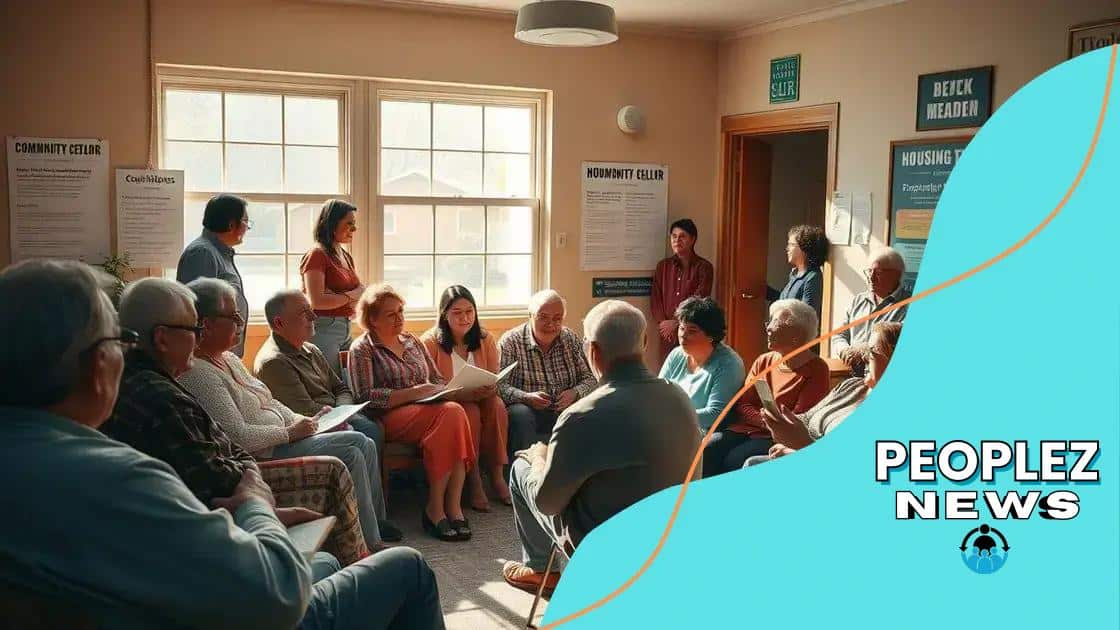Expanding access to affordable housing under new federal policies

Expanding access to affordable housing under new federal policies aims to provide greater stability, improve living conditions, and foster community growth, while overcoming challenges such as funding constraints and regulatory barriers.
Expanding access to affordable housing under new federal policies is a topic that affects many Americans today. Have you ever wondered how these changes might impact your community and the lives of families struggling with housing costs?
Understanding the new federal housing policies
Understanding the new federal housing policies is vital for anyone interested in affordable housing. These policies aim to make housing more accessible, benefiting families and communities across the nation. By promoting affordable housing options, these regulations support low-income families, ensure better living conditions, and encourage community growth.
Key Features of New Policies
The recent reforms introduce several essential features that aim to enhance the housing market:
- Increased funding for affordable housing development.
- Streamlined application processes for housing assistance.
- New incentives for developers to create affordable units.
- Enhanced protections for renters against eviction.
These features work together to create a more equitable housing environment. It is crucial to recognize how these policies affect local communities. By making housing more affordable, we can enable families to thrive and contribute to their neighborhoods positively.
Long-Term Goals
The long-term goals of these policies focus on sustainability and community development. Aiming for a broad reach, they seek to address the underlying issues that drive housing insecurity. For instance, improving public transportation and access to amenities can empower residents in affordable housing.
Moreover, federal programs encourage collaboration among local governments, non-profits, and private developers. This teamwork is essential to creating comprehensive housing strategies that work. Families benefit when they can access support systems that offer not just a place to live but also stability and opportunities for growth. Ultimately, the aim is to build communities where individuals can pursue their dreams without the burden of high housing costs.
Key benefits of affordable housing access
Key benefits of affordable housing access are essential for improving the quality of life for many families. These advantages extend beyond just having a place to live. They contribute to the overall well-being of individuals and communities.
Improved Standard of Living
Access to affordable housing allows families to allocate their incomes more efficiently. Rather than spending a large portion on rent, they can invest in essentials like food, healthcare, and education. This shift leads to:
- Better health outcomes for family members.
- Increased educational opportunities for children.
- A higher overall quality of life.
Each of these factors interconnects, resulting in stronger families and communities. When families don’t have to worry excessively about housing costs, they can focus more on building their futures.
Community Stability
Another significant benefit of affordable housing access is the stability it provides to neighborhoods. When residents can stay in their homes longer, communities grow more cohesive. This stability contributes to:
- Loyalty to the neighborhood.
- Stronger social ties among residents.
- An overall sense of safety and belonging.
As a result, communities become more vibrant and connected. With reduced turnover in housing, neighbors can build lasting relationships, leading to a supportive environment for everyone.
Additionally, affordable housing fosters diversity. It enables people from various backgrounds and income levels to coexist. This diversity brings cultural richness and varied perspectives, enhancing community life.
Challenges faced in implementing these policies

Challenges faced in implementing these policies can significantly impact the effectiveness of affordable housing initiatives. Even well-intentioned policies may encounter several obstacles that hinder their success.
Funding Constraints
One of the primary challenges is securing adequate funding. While the government may allocate resources, those funds are often not enough to meet demand. This shortfall can lead to delays in construction and reduced availability of affordable housing.
- Limitations on federal budget allocations.
- Competing priorities for state and local funding.
- Dependence on private investment for projects.
These factors can create gaps in financing, leaving many families without suitable housing options.
Regulatory Barriers
Another significant issue is the existence of regulatory barriers. Local zoning laws can restrict the types of housing that can be developed, limiting the availability of affordable housing. Additionally:
- Lengthy approval processes can delay projects.
- Bureaucratic hurdles can dissuade developers from engaging.
- Restrictive land use policies may prevent optimal development.
These regulations often do not adapt quickly to the changing housing landscape, which can stymie the creation of new housing options.
Cultural perceptions also play a role in the challenges of implementing these policies. Communities might resist new developments, fearing a loss of neighborhood identity. This pushback can lead to protests and legal challenges that complicate housing projects.
Furthermore, public awareness and understanding of affordable housing initiatives can be limited. Many residents may not grasp the benefits of such projects, leading to misinformation and opposition.
Community responses to housing initiatives
Community responses to housing initiatives often vary significantly. Understanding these reactions is crucial for developers and policymakers aiming to improve affordable housing options. Communities play an essential role in shaping how these initiatives are implemented.
Support from Local Organizations
Many local organizations and non-profits actively support affordable housing projects. They understand the necessity of such developments for community stability and growth. These organizations often:
- Advocate for policy changes to simplify housing applications.
- Provide resources and information to families in need.
- Engage in fundraising to support housing initiatives.
Through these efforts, they help educate the community about the benefits of affordable housing, fostering a more supportive atmosphere.
Concerns and Opposition
Not all community responses are positive; some residents express concerns about new housing projects. Fear of changes to neighborhood dynamics can lead to opposition. Common concerns include:
- Increased traffic and congestion.
- Changes to property values.
- Potential strains on local resources such as schools and parks.
Addressing these fears is vital for project success. Open dialogues between developers and community members can often alleviate concerns. When stakeholders engage in conversation, residents can feel heard and understood.
Furthermore, misconceptions about affordable housing can create resistance. It is essential to clarify that these projects can enhance communities rather than detract from them. Examples of successful projects can help reshape public perception, emphasizing the positive economic and social contributions that affordable housing can bring.
Future outlook for affordable housing programs
The future outlook for affordable housing programs appears promising yet complex. As communities nationwide grapple with housing shortages, the need for effective programs becomes increasingly urgent. Policymakers and advocates are committed to developing strategies that can address these challenges.
Innovation in Housing Solutions
One positive trend is the innovation within housing solutions. New building technologies are paving the way for more efficient construction methods. Examples include:
- Modular construction techniques that reduce costs and time.
- Green building practices that enhance sustainability.
- Adaptive reuse of existing buildings to serve as housing.
These innovations can help alleviate housing shortages while minimizing environmental impact. Communities that embrace these developments can create smarter, more sustainable living spaces.
Increased Collaboration
Collaboration is another key factor in the future of affordable housing programs. Government agencies, non-profit organizations, and private developers are starting to work more closely together. This collaboration fosters:
- Shared resources and expertise to tackle complex housing issues.
- Multi-faceted approaches that incorporate different perspectives.
- Community engagement to ensure that housing solutions meet local needs.
When all stakeholders participate, the likelihood of success increases significantly. Community input becomes invaluable, guiding projects toward what residents genuinely need.
As awareness grows around the importance of affordable housing, public support is also on the rise. More individuals are advocating for policies that promote housing accessibility. This shift in public sentiment bodes well for future initiatives aimed at expanding affordable housing options.
The future of affordable housing programs looks bright, filled with new opportunities and challenges. As communities come together to support these initiatives, collaboration will be key. Innovative solutions and greater public awareness can help address the pressing housing needs many families face. By fostering cooperation among stakeholders and embracing new technologies, we can create more affordable and sustainable housing options for everyone.
FAQ – Frequently Asked Questions about Affordable Housing Programs
What are the main benefits of affordable housing programs?
Affordable housing programs help provide stable living conditions, improve quality of life, and promote community growth.
How do communities typically respond to housing initiatives?
Community responses can vary, with some supporting the initiatives for improved living conditions while others may express concerns about changes to their neighborhoods.
What challenges do affordable housing programs face?
Challenges include funding constraints, regulatory barriers, and varying public perceptions about the impacts of affordable housing.
What is the future outlook for affordable housing initiatives?
The future looks promising, with increased collaboration, innovative building solutions, and growing public support for more inclusive housing options.





